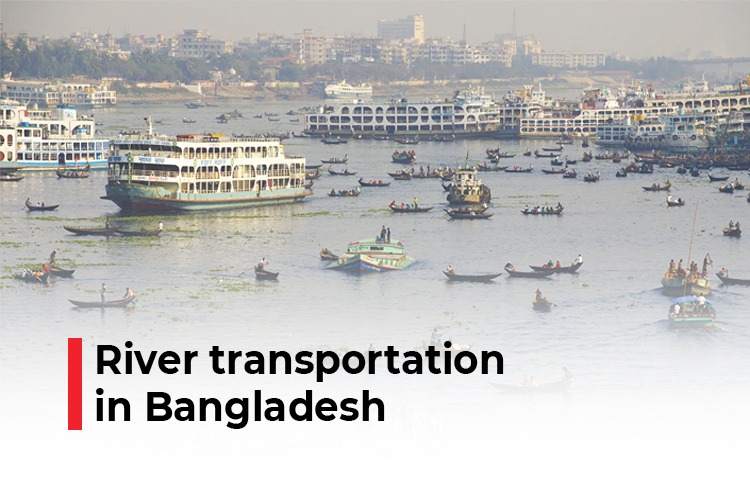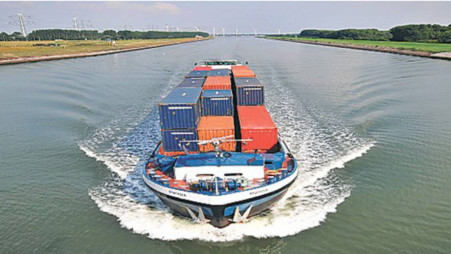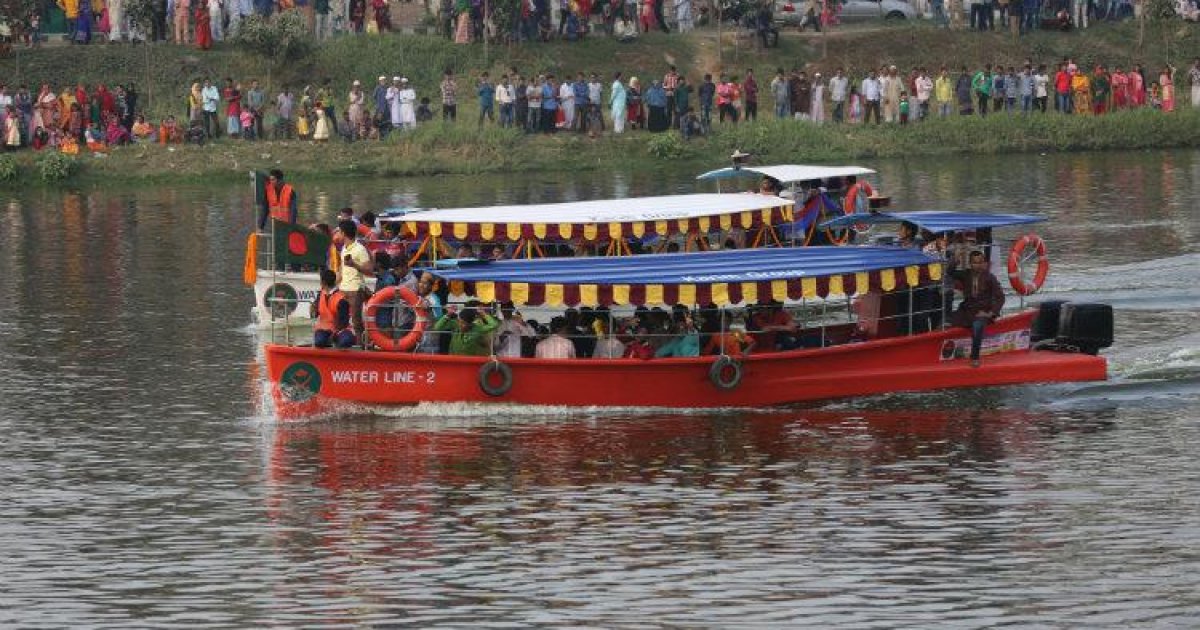
River Transportation in Bangladesh
Bangladesh is a country of rivers. Most of the goods from its seaports are transported through the country’s riverine routes. Occupying about 11% of the country, with some 700 natural rivers & tributaries and an overall 24,000 km-long network crisscrossing the country, Bangladesh has one of the largest inland waterway networks in the world, connecting almost all the major cities, towns, and commercial centers of the country. Almost 40% of the classified river network shrinks during the dry season, making navigation difficult. 6,000 km is navigable by larger vessels in the rainy season while in the dry season about 4,347 km is navigable.

Water Transport refers to the network for inland waterways. In Bangladesh about two-thirds of the land is vulnerable to flooding. Most areas remain under water for two to five months a year. As a result, costs of development and maintenance of roads and railways are high. On the other hand, inland water transport has always been a natural and relatively cheaper means of transport. In certain areas, it is the only mode of transport.
The inland navigable waterway routes as classified by Bangladesh inland water transport authority (BIWTA), a government body that sets design standards for vessels and regulates the operation of passenger and cargo vessels along their extensive waterway system, fall into four groups:
Class-I: Four trunk routes (depth 3.66 m – 3.96m, length about 683 km)- Chittagong-Chowkighata-Chandpur-Shambhupura-Narayanganj/ Dhaka; Shambhupura-Demra; Shambhupura-Bhairab Bazar/Ashuganj; and Chowkighata-Barisal-Mongla-Khulna-Maheswarpasha;
Class-II: Eight link routes (depth 1.83m – 3.65m, length about 1,000 km)- Mohanpur-Daikhawa; Bhairab Bazar-Chhatak; Chalna-Raimongal; Hijla-Saistabad; Satnal-Daudkandi; Chittagong-Cox’s Bazar; Diara-Barisal via Nandir Bazar; and Chandpur-Ichuli;
Class-III: Twelve secondary routes (depth 0.91m-1.82m, length about 1,905 km)- Dilalpur-Fenchuganj-Zakiganj; Chittagong-Kaptai; Rangamati-Kaptai; Kaptai-Belaichari; Rangamati-Chotohorina; Rangamati-Mahalchari; Rangamati-Marisha; Sripur (Bhola)-Nazirpur-Char Montaz; Jhalakati-Barguna- Patharghata; Charpower-Patuakhali-Galachipa-Bara Baishdia; Bara Baishdia-Khepupara-Mohipur; and Khulna-Bardia-Manikdah, and
Class-IV: Seasonal routes (depth less than 0.91m, length about 2,380 km). In addition to the above, there are many unclassified routes. Most of these routes are used by the country-boat sector.

The water transportation networks play a key role in the transportation of import and export cargo through the ports of Chittagong and Mongla. The following public sector generally provide all types of facilities, maintenances and make policies to stimulate the water transportation system in Bangladesh:
- Bangladesh Inland Water Transport Authority (BIWTA)
- Bangladesh Inland Water Transport Corporation (BIWTC)
- Chittagong and Mongla Sea-Port Authority
- Bangladesh Shipping Corporation (BSC)
The infrastructure facilities and services in the inland water transport (IWT) sub-sector are provided by the Bangladesh Inland Water Transport Authority (BIWTA) and the Bangladesh Inland Water Transport Corporation (BIWTC) respectively.
The current IWT system handles about 20 percent of the nation’s foreign trade through Class I perennial river Routes, navigable (day-night) throughout the year with lowest available 3.5-meter LAD (least available draft). In the Dhaka- Chittagong (DC) sea-river route, the LAD remains 4 meter throughout the year and the LAD is 3-4 meter (depending on the tide) in Dhaka-Mongla-Kolkata ( India ) river route via Sundarbans.
The seaports serving Bangladesh are Chittagong in the east and Mongla in the west. The port of Chittagong handles 90% of Bangladesh’s export-import trade. Payra seaport located in Potuakhali is now under construction and scheduled to be completed in 2023.
Bangladesh Inland Water Transport Authority (BIWTA) is responsible to maintain the waterways and operates 21 recognized inland river ports. Major inland rive ports are: Dhaka, Narayanganj, Chandpur, Barisal, Khulna, Patuakhali, Baghabari, Aricha, Nagarbari, Ashuganj, Pangaon, Daulatdia & Narsingdi. Some important ferry ghats are: Aricha, Nagarbari, Paturia, Daulatdia, Bhuapur, Sirajganj, Bhola, Laxmipur, Chadpur, Shariatpur, Mawa and Charjanajat.
Unfortunately, there are only three inland container terminals around Dhaka to handle containers in the country’s IWT system. These are Dhaka Inland Container Depot (ICD) at Kamalapur railway, Dhaka ICT at Pangaon and Summit Alliance ICT at Mukhtarpur. Some upcoming ICT (Inland Container Terminal) or river ports are Rupayan port & logistics at Narayangonj, Kumudini port at Narayangonj, A K Khan port at Narsingdhi, Anondo Shipyard at Meghnaghat and Meghna ICT at Gozaria.

In maritime shipping, the Bangladesh Shipping Corporation (BSC), a public sector organization provides about 60 percent of the services in respect of Dead Weight Tons (DWT), while Bangladeshi private sector provides only 40 percent. Presently, Bangladesh handles only 16 percent of the overall import and export cargo.
Currently more than 2000 sea-river cargo vessels of various dimensions (Max DWT 2500) ply in the Dhaka-Chattagram waterways and about 220 vessels in the Narayangonj- Kolkata (India). Various capacity lighter Cargo carrying goods from Chattogram and Mongla to all over Bangladesh
- Small size: 800 – 1200 MT
- Medium size: 1200 – 2000 MT
- Big size: 2000 – 2300 MT
Most of the imported goods – nearly ninety percent – reach different parts of the country by waterways, via Chittagong Port. Transportation of goods by waterways is substantially economical due to the fact that it costs one fourth or even less compared to other means of transportation. WTC (Water Transport Cell) is carrying out the operations with acceptable rates of transport costs and started to work as a coordinator among all stakeholders including the Importers, Vessel-Owners, Cargo Agents and Local Agents by providing other related services apart from ensuring stable transport rates of goods. For all concerned with water transport, WTC is presently performing as a One Stop Service Center. Vessels interested to transport goods from Chittagong Port or off the Coast have to be enlisted in the roster maintained by WTC. Everyone in this sector is bound to transport goods as per rules and regulations and rates of transport costs formulated by WTC. Current rate of freight for transporting clinker from Chittagong to Dhaka is Tk. 550 per ton.
The infrastructure problems on the inland waterways system are significant. Within Bangladesh there is high rate of siltation and bank erosion, and as a result it is difficult for the vessels to navigate along these waterways. Major parts of the corridor suffer from navigational hazards, such as shallow water, narrow width of channels and inadequate navigational aids. As a result, night navigation is allowed only on certain sections.
The inland waterway system is not used to its full potential, due in part to inadequate dredging and shortage of berthing facilities. Due to geographical position and topological condition of the country, rivers are becoming more and more narrow because of siltation. As such, implementation of comprehensive capital dredging program is the biggest challenge for the IWT sub-sector. Specific challenges identified in the sub-sector are:
o Channeling of the existing waterways through massive dredging and procurement of dredgers,
o Construction of deep sea port to streamline international trade,
o Improvement of day and night navigation for water crafts by providing navigational aids and construction of inland container river port for transportation of containers by waterways to/from sea ports etc.
The government is implementing a massive program to make the country’s foreign and internal trade easier and competitive by enhancing the capacity of sea, river and land ports using modern technology and equipment. Dredging and other activities have been taken up along 53 routes of inland waterways to increase navigability. To enhance the goods handling capacity of the country’s seaports and raise their standards to the international level, plans have been taken up to construct new container terminals, overflow container yards, bay terminal and bulk terminal, and procure vessels. In order to improve the handling capacity of river ports, plans have been taken up to build inland container river-ports, erect pillars along the riverbanks, safeguard riverbanks, construct necessary structures including walkways and jetties, and remove waste from riverbeds. The Government has taken steps for the modernization and capacity building of Bangladesh Shipping Corporation and Bangladesh Inland Water Transport Corporation.
For those organizations planning to set up a factory and requiring to import raw materials in bulk, an optimization of primary freight costs could be achieved by choosing a location within close proximity of an inland river route with an acceptable draft throughout the year. This will facilitate the movement of all types of light riverine vehicular traffic. An alternative could be to have a third party jetty near the factory.
Given below are the required processes and documentations, for getting permission to construct a jetty.
Documents required for foreshore license application
- Updated Land document: Applicant must have a land (own or rental) on the bank of respective river. All land papers (deed of agreement,
Mutation, Khazna, Khariz, Tax etc.) must be updated.
- Company document and Trade License.
- National Identity Card (NID) and passport color photographs
of the company owner - Company seal.
Application Process
- An application form is to be collected from Bangladesh Inland Water Terminal Authority (BIWTA). Filled out application form along with necessary documents, to be submitted to BIWTA.
- Respective local BIWTA office will check submitted documents and survey the project area. After the survey BIWTA will generate a recommendation report for the project and send it to the head of BIWTA, Dhaka for approval of foreshore license.
- After the Govt. approval, foreshore license fee has to be paid to the BIWTA local office. Then both parties (BIWTA and the company) will sign an agreement for foreshore license.
- License needs to be renewed annually by paying a renewal fee. License fees are fixed in the approval process based on the jetty size and capacity.
- There is a Loading-unloading charge of $ 0.35 per MT. All charges of the BIWTA have to paid from time to time.
- Jetty to be constructed in the company land by making it as basin.

infinigent consulting Ltd
infinigent Consulting Ltd. is a multinational strategic management consulting firm operating in India, Canada, and Bangladesh, with plans to expand to Singapore and Dubai. Our diverse team of international and local experts delivers tailored solutions to address business challenges. By closely collaborating with clients, we focus on improving organizational performance through customized, effective strategies.